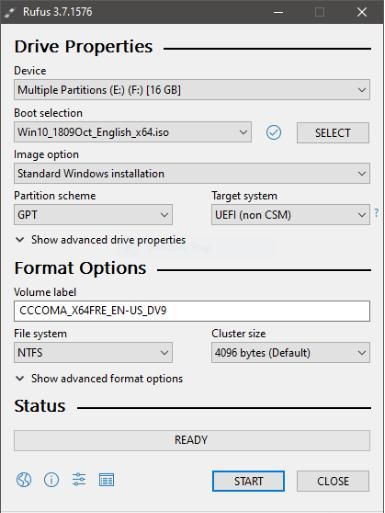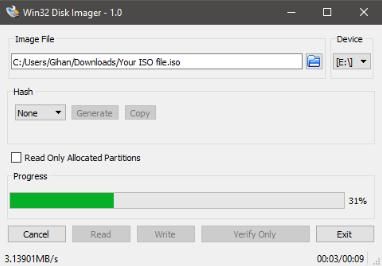Rufus vs. Win32 Disk Imager: Similarities and Differences
Rufus and Win32 Disk Imager are two popular software tools used to create bootable USB devices. While both are effective in their purpose, they have distinct differences that make one more suitable than the other depending on individual needs. Professionals often seek detailed comparisons between the two to determine which one best meets their requirements.
Rufus and Win32 Disk Imager are two popular, free, and open-source software tools used to create bootable USB drives. Both tools are designed to write an ISO image to a USB drive, allowing users to boot from the USB drive. Rufus is a more feature-rich tool that offers additional options, such as the ability to format the USB drive, create a bootable USB drive from a local file, and support for multiple file systems. In contrast, Win32 Disk Imager is a simpler tool that focuses primarily on writing an ISO image to a USB drive.
What Is Rufus
Rufus is a widely used and famous software that transforms portable drives like USBs or flash drives into bootable drives, serving a large community of developers with multiple contributors to its GitHub repository.

Rufus is a versatile tool that can be used to run low-level utilities, such as flashing firmware, from a DOS environment. It's particularly useful for systems without an operating system, making it easy to create USB installation media from various ISOs, including UEFI, Linux, and Windows.
Features of Rufus:
- Popularity: It has a large community that can use dedicated support in over 38 languages, and the documentation provides solutions to all possible issues, making it easy to quickly resolve specific and code-related problems.
- System requirements: Rufus is a portable tool that runs on Windows 7 or later, requiring only 512MB RAM, and doesn't need to be installed, making it easy to download and use from the website.
- Functions: Rufus is a popular tool that doesn't require removable hardware to be plugged in before use, setting it apart from other counterparts. Its essential functions include automatic detection of removable hardware in the system, bad block checking, making customized icons, and extended partition labels, making it a valuable utility for users.
- High performance: Rufus is the fastest option available, offering a balance between ease of use and advanced features for professionals.
What Is Win32 Disk Imager
Win32 Disk Manager is a highly competitive alternative to Rufus, ideal for saving and restoring images from removable devices like memory cards, SD, and USB drives. It's easy to use and allows you to write boot images to a USB flash drive or SD flash drive, making it a convenient option for various tasks.

Win32 Disk Imager allows users to quickly download and write ISO images to removable drives. The software has a simple interface, making it easy to format the drive, select the ISO, and start the writing process. It is lightweight, requiring only 100 MB of space, and works seamlessly on all PCs. Additionally, it offers features such as opening last opened folders, reading-only allocated partitions, and language translation for global use.
Features of Win32 disk imager:
- Popularity: Win32 Disk Imager is a lesser-known but strong competitor to top bootable USB software like Rufus. The team quickly answers daily developer queries, providing users with rapid assistance.
- SThe system has minimal hardware requirements and works efficiently on systems with 512MB RAM, making it highly flexible to Windows systems compared to Rufus or other options.
- Functions: Win32 Disk Imager is a useful tool for backing up data from mobile devices, particularly SD cards. It requires ISO files in advance, making it ideal for creating backups. The feature is extremely helpful for users who want to quickly back up photos or other data from their mobile devices, making it a significant feature of the software.
- High performance: Win 32 disk imager is a fast and efficient software that works well with both Windows and Ubuntu operating systems. It features a user-friendly graphical interface with a simple, Microsoft Windows-like design.
Rufus vs. Win32 Disk Imager
After going through the easy-Rufus and Win32 Disk Imager are two free software tools used to create bootable USBs. Despite their similarities, they have key differences. Both tools allow users to create bootable USBs from ISO files, but Rufus offers more advanced features such as support for UEFI and GPT, as well as the ability to format the USB drive. Win32 Disk Imager, on the other hand, is more focused on creating exact copies of a USB drive, making it a better choice for users who need to preserve the original content of the drive. Ultimately, the choice between Rufus and Win32 Disk Imager depends on the user's specific needs and requirements.
Similarities in Rufus and win32 disk imager:
Here are the top standard features of Rufus and Win32 Disk Imager software in one paragraph:
- Both are available for Windows and Linux operating systems.
- Both are open-source license software.
- Both can create amazing bootable USBs.
- Both offer dedicated UEFI support.
- Both can burn ISO.
- Both can create bootable backup and allow the quick download of ISO images.
- Both can write ISO to SD card.
- Both are lightweight and highly portable tools.
- Both offer automatic downloading.
- Both possess material design.
- Both are available in different languages.
- Both offer disk-to-image file conversion and disk imaging.
- Both allow quick backup.
Differences in Rufus and win32 disk imager:
The critical differences between Rufus and Win32 Disk Imager lie in their functionalities and approaches. While both tools are used for creating bootable USB drives, Rufus offers more advanced features such as UEFI support, GPT partitioning, and the ability to create a bootable USB drive from a DVD or CD. In contrast, Win32 Disk Imager is a simpler tool that focuses on creating a direct copy of an ISO file to a USB drive, without any additional features.
| Feature | Rufus | Win32 Disk Imager |
|---|---|---|
| Disaster recovery and incremental backup | No | Yes |
| Cloning to small disks, fast cloning, disk cloning, etc. | No | Yes |
| Formatting SD to NOOBS-compatible format | No | Yes |
| Cleaning unwanted partitioning | No | Yes |
| Live booting from USB | No | Yes |
| Creating bootable CD | Yes | No |
| Arch Linux base | Yes | No |
| Converting Img to ISO | Yes | No |
| Portable and persistent Linux | Yes | No |
| No need for formatting | Yes |
No |
| Command line, command line support, and command line interface | Yes | No |
| Utilities for deleting files | Yes | No |
| Installation to internal hard drives or SSDs | Yes | No |
| Creating multiboot USB, multiboot USB, and multiboot | Yes | No |
| UDF extension support | Yes | No |
| Optimal performance | Yes | No |
| Linux or GNU libre | Yes | No |
| USB to UDF, NTFS, and FAT | Yes | No |
| Installing DOS to USB | Yes | No |
| Creating BIOS bootable drive, bootable USB, and UEFI bootable drive | Yes | No |
| Checking bad blocks | Yes | No |
Wrap up
The similarities and differences between Rufus and Win32 Disk Imager are easy to understand, making it simple for users to choose the one that best suits their needs. A detailed comparison of the two tools highlights their key similarities and differences, allowing users to select the one that meets their requirements.
Win32 Disk Imager and Rufus are both popular tools for creating backup files and bootable USB drives. While Win32 Disk Imager excels on Ubuntu, making it easy to work with, Rufus has a more comprehensive feature set that makes it a preferred choice for creating bootable USB drives. Ultimately, the choice between the two tools comes down to individual user needs.
Related Articles
- What Is a TPM, How to Check and Enable TPM 2.0 for Windows 11 [Full Guide]
- What Is NFS and How Does It Work? [This Might Help You]
- What is USB 4: All You Need to Know [ 2022 Complete Understanding]
- Windows 11 Is Not Activated: How to Activate Windows 11 OS for Free